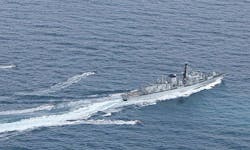Navy considers 360-degree multispectral persistent surveillance for surface ship defense
CRANE, Ind., 10 June 2014. U.S. Navy shipboard electronics experts are sending feelers out to industry to find companies interested in developing an electro-optical sensor that provides 360-degree multispectral persistent surveillance capability.
Officials of the Naval Surface Warfare Center (NSWC) in Crane, Ind., have issued a request for information (N0016414SNB24) for the Components for a 360 Degree Electro-Optical/Infrared (EO/IR) Persistent Surveillance System for U.S. Navy Ships program.
This kind of capability would give Navy ships the ability to gather high-resolution video and images all around the vessel in daylight, at night, and in bad weather. Potentially this capability could enhance shipboard defenses against fast maneuverable missile boats attacking with swarm tactics, and similar threats.
Such a long-range day/night/all-weather surveillance capability also holds the potential to slave 360-degree electro-optical sensors to advanced shipboard systems like laser weapons to help defend Navy surface warships from swarm tactics such as those being developed by Iran in the Persian Gulf.
Related: Hypertemporal imaging: the next Big Challenge for high-performance embedded computing
The 360 Degree Electro-Optical/Infrared (EO/IR) Persistent Surveillance System for U.S. Navy Ships program is still in its infancy, and Navy officials warn that they do not yet have the funding to release formal solicitations and award contracts.
Navy surface warfare experts say they are contemplating industry-day briefings to industry on their plans for the program sometime in September or October 2014. Industry briefings could include the best industry ideas gathered from this RFI, officials say.
NSWC Crane officials say they expect eventually to invite industry to demonstrate 360-degree multispectral sensors for shipboard use at the NSWC Crane Joint Electro Optics Center's towers, laboratories, target boards, and Greenwood Lake -- an 820-acre body of fresh water adjacent to the base at NSWC Crane.
Related: Air Force chooses Space Computer for advanced persistent-surveillance sensor processing
Companies interested should respond no later than 18 July 2014. Email technical questions or concerns to Matthew Thurner at [email protected]. The contracting point of contact is Michael Allen, whose email address is [email protected].
More information is online at https://www.fbo.gov/spg/DON/NAVSEA/N00164/N0016414SNB24/listing.html.

